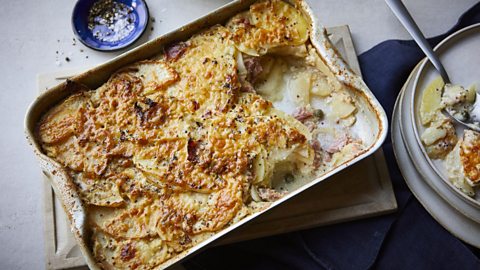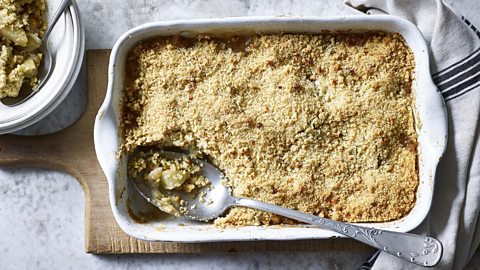How to cook once a week and eat well every day

by Hattie Ellis
We all want to eat fresh food in dishes cooked from scratch, but how do we achieve that with limited time and energy? One solution is to do most of the cooking in a single session each week. Choose your best time, download a podcast or turn on the radio, then chop, stir and taste. By the end of three hours or so, youÔÇÖll have delicious dinners for the whole week ÔÇô IÔÇÖm cooking for two people; it may take a little longer if youÔÇÖre feeding more.
The idea is to use your hob and oven to the max. Then cool down the dishes as quickly as possible, cover them, and put them in the fridge or freezer. Some might be one-pots, others ÔÇśalmost-ready-mealsÔÇÖ ÔÇô just add pasta, rice or salad leaves on the day you eat them.
The cook-once-a-week approach is energy-efficient too. When I put the oven on I try to fill it up to make the most of the heat, and I use a microwave to reheat the food. Remember timings for recipes will change a bit when youÔÇÖve loaded up the oven, as this brings down the temperature slightly and dishes take longer to cook.
Pans on the hob
On the hob, I often make a grain-based dish, such as barley cooked with stock and meat or veggie sausages. Rice dishes such as risotto or a pilau need to be refrigerated quickly after cooking, consumed within and, as with all these cook-ahead dishes, reheated until piping hot.
Alongside is a hearty stew ÔÇô I add lentils or a can of beans to a meat stew to bulk it out, increase fibre and cut costs, or I make a rich bean-based stew such as a veggie chilli, or simple lentils braised with onions, carrots, celery and garlic. Then I steam a mixture of greens, such as leeks, cabbage and peas ÔÇô enough for up to four meals.
Start by chopping a double quantity of onions, celery and carrots. Then divide this into two pans and continue with your recipes (many grain-based dishes can be adapted to use this base). Sometimes I do a triple quantity and use the extra to make soup. Add chopped bacon or chorizo for a stronger flavour, or vary this base according to your cuisine, for example frying onions, garlic, chilli and spices for an Indian dish.
Load up the oven
Into the oven, I might put a root-vegetable gratin, which can be eaten as a main course one day and a side-dish another. My warming winter gratin includes slices of celeriac cooked with cream, mustard and capers. This is a classic flexitarian dish ÔÇô add ham or a tin of anchovies if you want.
Or use a traybake recipe, such as those written by Rukmini Iyer. These are ideal for the time-pressed cook and lots of them are well suited to cooking ahead.
On the top rack of the oven, roast a tray of chopped veg, which you can eat as a side during the week. Everything you roast improves in the oven ÔÇô especially vegetables, because their flavours concentrate as they lose water. The trick is to chop each type of veg to the same size so they cook evenly, and to give it all a good stir halfway through as veg at the edges of the tray will cook more quickly. And know your oven ÔÇô some are much hotter at the front than the back. Turn the tray around halfway through and use a big spoon to move the veg on the edges into the centre and those in the centre to the edges.
What you roast depends on the season and what needs using up. It might be butternut squash, chopped into 3cm/1in cubes, with quartered red onions and some garlic cloves or sprigs of rosemary, or potato wedges flavoured with quartered lemons and smoked paprika, or carrot wedges and fat slices of fennel. Courgettes are transformed by being cut into matchsticks or thin slices and roasted with lemon juice and zest until brown and tasty. In the summer, cubed aubergines, quartered tomatoes and thin wedges of courgette make a traybake ratatouille ÔÇô stir in torn basil at the end. Whatever you make, toss it with olive oil and season well before it goes in the oven.
ItÔÇÖs handy to cook a pud too, especially if youÔÇÖre cooking at the weekend and want a Saturday or Sunday treat. A crumble can go into the oven at the same time as your veg and gratin, or afterwards if space is tight.
Use the last of the oven heat
Finally, turn down the oven and use the last part of the heat to make something to nibble on or to add oomph to other dishes, such as granola, spiced nuts, or oven-dried tomatoes. This last dish makes the most of inexpensive tomatoes. Cut them in half and sprinkle over equal parts salt and sugar mixed with chilli flakes or dried oregano. Bake in a medium-low oven until dried out. A simple pasta sauce can be made by chopping and heating up some of these tomatoes with a tub of mascarpone and chopped herbs and garlic.
Three rules for this type of cooking
There are three principles to remember with once-a-week, cook-ahead food. Firstly, choose at least one type of food, such as stews, curries and lentils, that will improve in flavour over time. French cooks deliberately make a braise ahead of eating because the flavours mingle as the food sits in the fridge.
Secondly, remember that appetite fades with repetition. Ok, students often make a big pot of veggie curry and eat it through the week. (I once got to the bottom of the pot in our student flat and found a herbal teabag someone had lobbed in; at least it wasnÔÇÖt a mouse!). But most of us need to freshen up a dish each time we eat it. What works as a main dish one day can be a supporting player the next, or slightly tweaked to make it new and delicious again. This can be done by adding another ingredient, such as smoked mackerel, herbs or just a squeeze of lemon.
Thirdly, public health advice is to freeze leftovers after two days. Check carefully whether your frozen meals need to be defrosted before eating.
Your Sunday cooking session
HereÔÇÖs a menu plan, as an example ÔÇô entirely adaptable to your tastes and recipes. ItÔÇÖs intended to feed two people, but if youÔÇÖre feeding a family then just cook more (and share the chopping tasks).
Your Sunday cooking session
Hob: Barley cooked with sausages; braised lentils; steamed greens.Oven: Winter warming gratin; roasted veg; crumble; oven-dried tomatoes and/or toasted nuts.
What to eat when
Sunday: Half the winter gratin with roasted veg and steamed greens, plus crumble (eat the rest during the week when you need cheering up).Monday: Barley with sausages and oven-dried tomatoes, plus salad on the side.Tuesday: Braised lentils with some of the barley, plus steamed greens.Wednesday: Smoked mackerel, or meat or vegetarian alternative, with a quarter of the winter gratin and some roasted veg (add a squeeze of lemon first).Thursday: Salad with toasted nuts and blue cheese, plus the last of the winter gratin.Friday: Lentils, sausages and oven-dried tomatoes, served with bread. Or cook a piece of meat, fish or veggie alternative.Saturday: Pasta with oven-dried tomato sauce.

